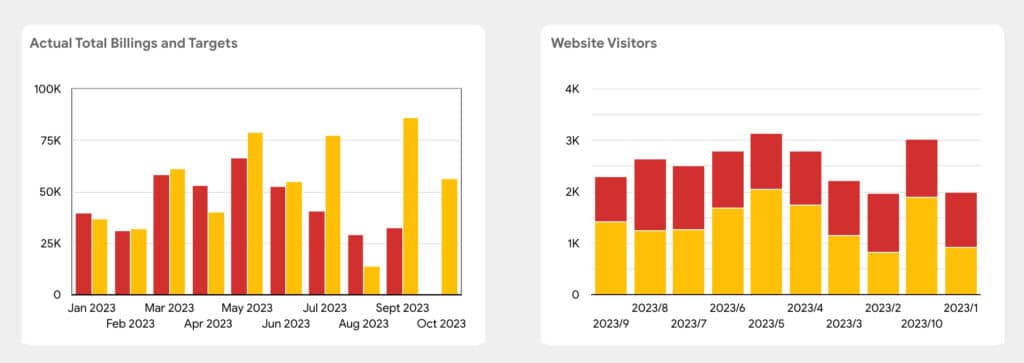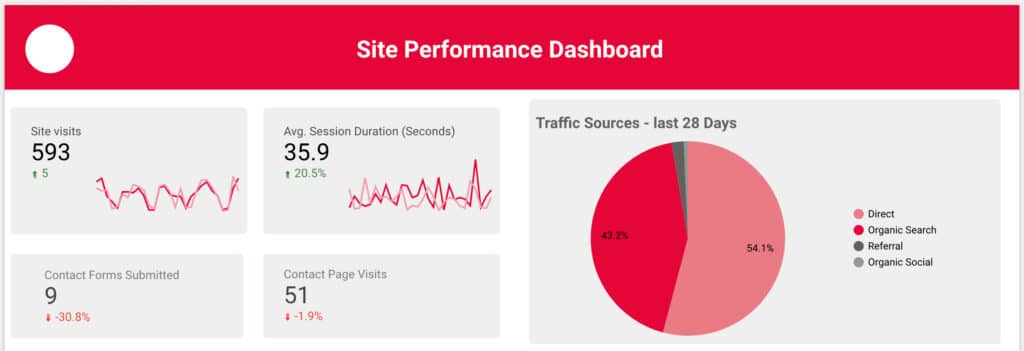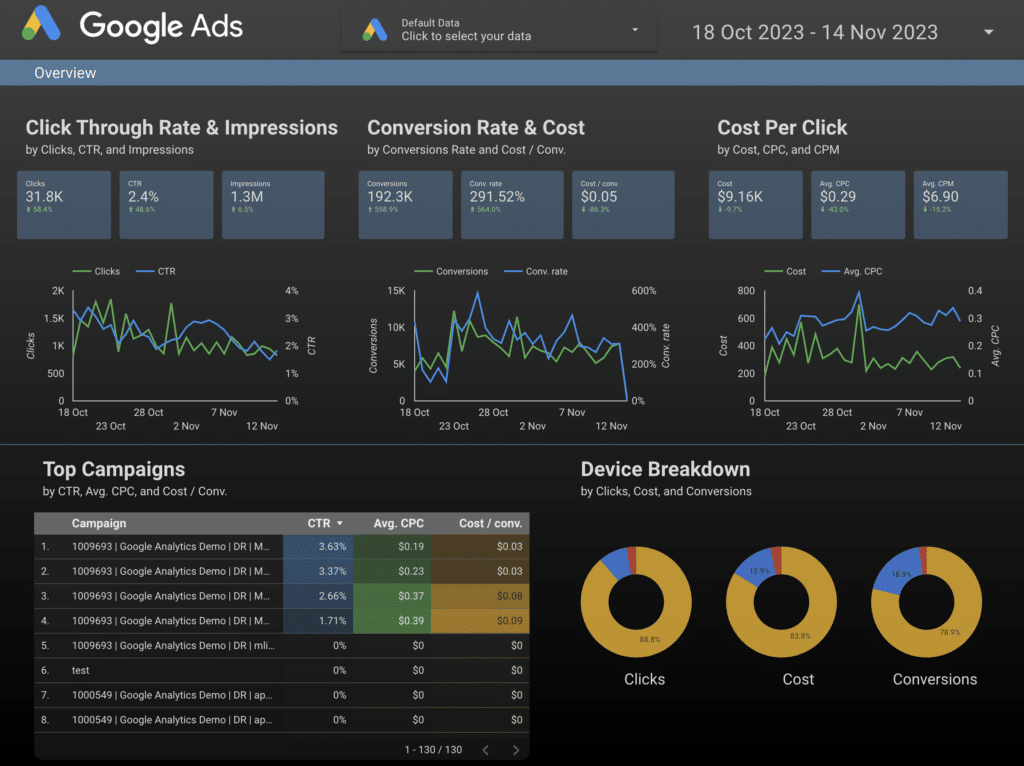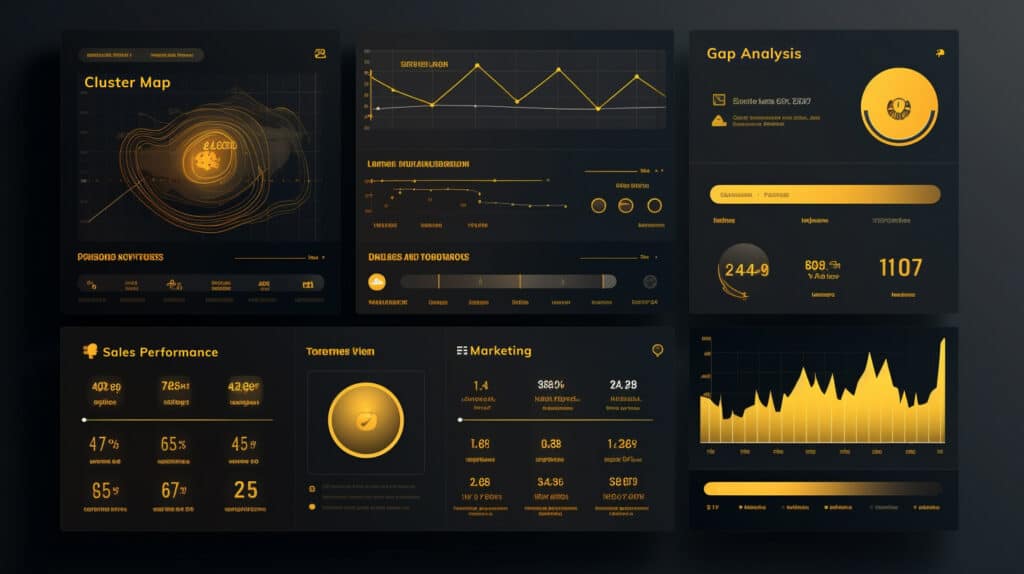

Devstars
Creating a custom business dashboard providing real-time data insights means you have at a glance access to all the important numbers needed for your business.
Custom business dashboards are powerful tools that can streamline your business processes, provide real-time data, and enhance decision-making. In this guide, we will explore everything you need to know about implementing an online dashboard that can compile raw data from different data sources for your business.

Whether you are a small startup or a large corporation, a custom dashboard can revolutionize your business operations. Say goodbye to hours of manual data analysis and hello to automated insights. Join us as we delve into the many benefits of a custom dashboard and discover how it can help your business thrive in today’s fast-paced digital world.
A custom dashboard is specifically tailored to meet the unique needs of your business. It consolidates all your data into one centralized location, allowing you to track key performance indicators easily, Google Analytics, monitor sales, manage inventory, and much more. With customisable widgets and visualizations, you can easily visualize and analyze your data, enabling you to make data-driven decisions that drive success.
One of the biggest benefits of using a custom dashboard is gaining real-time insights into your business operations. Instead of relying on outdated reports or manually collecting data from multiple sources, a custom dashboard can provide you with all up-to-date information. This allows you to identify trends, spot opportunities, and address issues before they become major problems.

Another major advantage of using a custom dashboard is the ability to improve collaboration and communication within your organization. With a centralized dashboard, all departments can access the same data, ensuring everyone is on the same page. This eliminates silos and encourages cross-functional collaboration, leading to increased productivity and better decision-making.
In addition to these benefits, a custom dashboard can also help you save time and reduce costs. By automating data collection and analysis, you can free up valuable resources that can be allocated to other important tasks. Moreover, a custom dashboard can help identify inefficiencies and bottlenecks in your business processes, allowing you to optimize operations and reduce costs.
Using a custom dashboard for your business operations offers numerous benefits, including real-time insights, improved collaboration, time and cost savings, and optimized operations. Now that we’ve explored the advantages let’s dive deeper into the types of data that can be tracked and monitored using a custom dashboard.
A custom dashboard allows you to track and monitor a wide range of data, helping you gain valuable insights into different aspects of your business operations. Here are some key types of data that can be tracked and monitored using a custom dashboard:
1. Sales and Revenue: With a custom dashboard, you can easily track your sales and revenue in real-time. This includes monitoring sales by product, region, or channel, identifying top-selling products, and analyzing revenue trends. By clearly viewing your sales performance, you can make informed decisions to maximize revenue and improve sales strategies.
2. Marketing and Advertising: A custom dashboard can help you track the effectiveness of your marketing and advertising campaigns. You can monitor key metrics such as website traffic, conversion rates, click-through rates, and social media engagement. This allows you to identify which campaigns generate the best results and allocate resources accordingly.
3. Customer Behavior and Satisfaction: Understanding customers is crucial for business success. A custom dashboard can provide insights into customer behaviour, such as purchase patterns, lifetime value, and customer satisfaction scores. This information can help you tailor your products and services to meet customer needs and improve overall satisfaction.
4. Inventory and Supply Chain: Managing inventory and supply chain can be complex, especially for businesses with multiple locations or suppliers. A custom dashboard can help you track inventory levels, monitor stockouts, and optimize supply chain processes. This ensures that you have the right products in stock at the right time, minimizing inventory holding costs and improving customer satisfaction.
5. Financial Performance: Keeping track of your financial performance is essential for business sustainability. A custom dashboard can provide insights into key financial metrics such as cash flow, profit margins, and return on investment. By monitoring these metrics, you can identify areas for improvement and make informed financial decisions.
These are just a few data types that can be tracked and monitored using a custom dashboard. The possibilities are endless, and you can customise your dashboard to suit your specific business needs. Now that you know the data that can be tracked let’s move on to the next section to learn how to choose the right custom dashboard for your business.

Choosing the right custom dashboard for your company is crucial to ensure that it meets your needs and provides the required insights. Here are some key factors to consider when selecting a custom dashboard:
1. Define your objectives: Define your objectives and what you want to achieve with a custom dashboard. Identify the key metrics and data points most important to your business. This will help you narrow your options and select a dashboard that aligns with your goals.
2. Ease of use: A user-friendly interface is essential for a custom dashboard. It should be intuitive and easy to navigate, allowing you to access and analyze data without any technical expertise. Consider the level of technical skills required to operate the dashboard and ensure it matches the capabilities of your team.
3. Data integration: Ensure that the custom dashboard can integrate with your existing systems and data sources. It should be able to pull data from various sources, such as CRM software, accounting systems, and marketing platforms. This will ensure that you have a holistic view of your business operations.
4. customisation options: Look for a custom dashboard that offers a high degree of customisation. This includes the ability to create custom reports, dashboards, and visualizations. The dashboard should allow you to tailor it to your specific requirements and display the data in a way that makes sense to you.
5. Scalability: Consider the scalability of the custom dashboard. As your business grows, your data requirements may change. Ensure that the dashboard can handle increasing data volumes and accommodate future growth.
These are just a few factors to consider when choosing a custom dashboard for your business. Remember to involve key stakeholders, such as department heads and IT personnel, in the decision-making process. Now that you have an understanding of the selection criteria, let’s move on to the next section to explore the key features to consider when building a custom dashboard.
Here are a few of the leading tools for building custom dashboards
Creating a custom dashboard requires careful planning and consideration of key features that will make it practical and user-friendly. Here are some key features to consider when building a custom dashboard for your business:
1. Drag-and-drop interface: A drag-and-drop interface allows you to customise your dashboard without coding or IT support. This feature makes adding or removing widgets, rearranging data visualizations, and creating custom reports simple.
2. Real-time data updates: Ensure your custom dashboard provides real-time data updates. This allows you to monitor your business operations in real-time and make informed decisions based on the most up-to-date information.
3. Data visualization options: Look for a custom dashboard offering a wide range of options. This includes charts, graphs, tables, and maps. Visualizing data in different formats allows you to gain insights quickly and easily.
4. Alerts and notifications: Alerts and notifications are essential for staying informed about critical changes in your business operations. Look for a custom dashboard that allows you to set up alerts based on specific criteria, such as a sudden drop in sales or inventory levels reaching a minimum threshold.
5. Mobile accessibility: Access to business data on the go is crucial in today’s digital world. Ensure your custom dashboard is mobile-friendly and can be accessed from smartphones and tablets. This allows you to monitor your business operations even when you are away from the office.
These are just a few key features when building a custom dashboard. The specific features you choose will depend on your business requirements and the needs of your team. Now that you understand the key characteristics, let’s move on to the next section to learn how to create a custom dashboard for your business operations.

Creating a custom dashboard for your business operations involves several steps. Here are the key steps to follow:
1. Define your objectives: Start by defining your objectives and what you want to achieve with the custom dashboard. Identify the key metrics and data points most important to your business.
2. Gather data: Identify the data sources you need to integrate into your custom dashboard. This may include CRM software, accounting systems, marketing platforms, and other data sources.
3. Choose a dashboard tool: Select one that meets your requirements and offers your desired features. Several dashboard tools are available in the market, ranging from simple drag-and-drop interfaces to more advanced solutions with advanced analytics capabilities.
4. Design your dashboard: Once you have chosen a dashboard tool, it’s time to design your custom dashboard. Start by selecting the widgets and visualizations that you want to include. Arrange them logically and intuitively, ensuring the most important data is easily accessible.
5. Integrate data sources: Connect your data sources to the custom dashboard. This may involve importing data files, setting up API connections, or using data connectors provided by the dashboard tool.
6. Configure data visualizations: Configure the data visualizations to display the data in a way that makes sense to you. This may involve selecting the type of chart or graph, applying filters, or setting up custom calculations.
7. Test and refine: Once your custom dashboard is set up, test it thoroughly to ensure that the data is accurate and the visualizations are working as expected. Make any necessary adjustments or refinements based on user feedback.
Following these steps will help you create a custom dashboard that meets your business requirements and provides the insights you need. Now that you understand the creation process, let’s move on to the next section to explore best practices for implementing and maintaining a custom dashboard.
Implementing and maintaining a custom dashboard requires careful planning and ongoing attention. Here are some best practices to follow:
1. Align with business objectives: Ensure that your custom dashboard aligns with your business objectives. Regularly review and update the metrics and data visualizations to ensure they are still relevant and provide meaningful insights.
2. Regularly update data: Keep your data up to date by regularly updating the data sources connected to your custom dashboard. This ensures that you have the most accurate and timely information available.
3. Ensure data accuracy: Regularly check the accuracy of your data by comparing it with other sources or conducting manual checks. Data inaccuracies can lead to incorrect insights and decisions, so it’s crucial to maintain data integrity.
4. Track user engagement: Monitor user engagement with the custom dashboard to identify any usability issues or areas for improvement. Collect user feedback and make adjustments as needed to ensure a positive user experience.
5. Provide training and support: Continuously provide training and support to your team to ensure they are making the most of the custom dashboard. Offer user guides, video tutorials, and regular training sessions.
6. Regularly review and update: Regularly review the performance of your custom dashboard and make updates as needed. This includes adding new data sources, refining data visualizations, or incorporating new features based on user feedback.
8. Train your team: Provide them with the necessary resources and support to make the most of the dashboard and empower them to make data-driven decisions.
By following these best practices, you can ensure your custom dashboard’s successful implementation and maintenance. Now that we’ve explored best practices let’s move on to the next section to learn from real-world case studies of businesses that have successfully streamlined operations with a custom dashboard.
While a custom dashboard offers numerous benefits, there can be challenges associated with its implementation and usage. Here are some common challenges and how to overcome them:
1. Data integration: Integrating data from different sources can be complex, especially with multiple systems or databases.
Solution: Ensure your custom dashboard supports data integration and provides connectors or APIs to connect to various data sources.
2. Data accuracy: Data accuracy is crucial for making informed decisions.
Solution: Regularly validate and reconcile your data with other sources to identify any inconsistencies or errors. Implement data validation checks to minimize the risk of inaccurate data.
3. User adoption: Getting your team on board and using the custom dashboard can be challenging.
Solution: Provide comprehensive training and support to your team. Communicate the benefits of using the dashboard and how it can improve their day-to-day work.
4. Complexity: Building and maintaining a custom dashboard can be complex, especially if you lack the technical expertise.
Solution: Consider working with a dedicated dashboard development team or hiring a dashboard consultant to guide you.
The best way to access, analyze, and act upon complex data in the modern digital landscape is through a custom business dashboard. Specifically designed to serve the unique needs of your enterprise, this new dashboard integrates data from different sources, providing a centralized platform replete with interactive dashboards and real-time updates. This empowers team members to make better decisions by offering all the necessary data at their fingertips.
The pinnacle of team productivity lies in the dashboard’s ability to simplify intricate business procedures. By amalgamating various data sources into one cohesive online dashboard, the arduous task of manual data entry becomes a thing of the past. This not only saves a lot of time but also minimizes the risk of human error. Thanks to the real-time data analytics feature, your team can stay ahead of the curve, making well-informed decisions without the hassle of toggling between multiple platforms.
One of the best parts of this dashboard solution is its adaptability across mobile devices and web browsers. Whether you’re on the move and accessing it via mobile phones or sitting at your workstation, you’ll always have pertinent, up-to-the-minute information at your disposal. This is particularly beneficial for remote team members who can stay in the loop and contribute effectively from anywhere.
Bid farewell to decision-making based on intuition or crude estimates. With visual aids like sales dashboards and customisable widgets, interpreting complex data has never been easier. The dashboard’s user-friendly designs, complemented by adjustable background colors and graphical representations, provide a more straightforward way to identify trends, opportunities, and challenges. This business intelligence is critical for strategic planning and proactive problem-solving.
Our custom dashboard offers seamless integration for those who are already accustomed to using Google Sheets for data management. This means you can import data directly from your Google spreadsheet, ensuring the dashboard is a comprehensive tool for all your business needs.
In summary, a custom business dashboard is not merely a luxury but a necessity in today’s fast-paced business environment. They offer an unparalleled avenue for gathering and analyzing data, enhancing team productivity, and, ultimately, leading your business toward data-driven success.
Send us a brief message outlining
your project and we’ll get back to
you asap to discuss your project
in more detail.